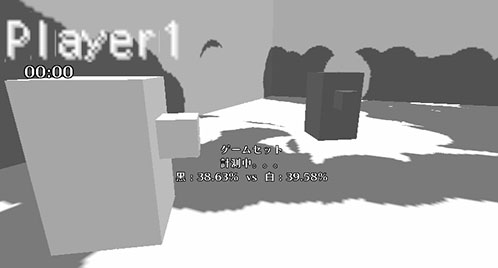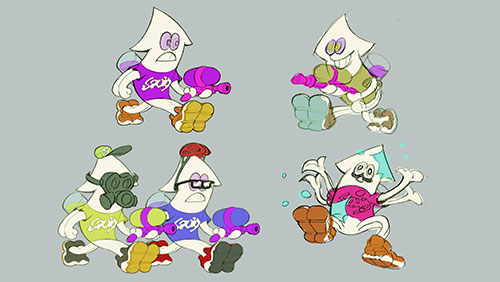Iwata Asks: Splatoon summary and a look at some prototype designs
The latest Iwata Asks focusing on Splatoon has all sorts of interesting details about the game’s development. Additionally, the team even shared a few prototype designs from the project. You can find those images below, plus plenty of tidbits about how Splatoon came together. Did you know that it was only 10 percent complete at E3 2014?
Part 1
– The reaction to Splatoon at last year’s E3 was better than expected
– Amano made the announcement trailer
– This is different than usual since trailers tend to be made by an outside agency
– Splatoon began after Nogami finished working on Wii U’s launch; he worked on the system’s menu
– Nogami gathered the Wii U launch team members about creating “a new kind of game, without worrying about trying to fit into existing game genres”
– The team got together practically every day and brainstormed potential ideas
– There were over 75 ideas shared in about 6 months
– The last new character from EAD was 14 years ago (Pikmin)
– The team wasn’t trying to create a new character, but instead a new game structure

– Program director Sato made a demo, which had a white cube in a maze (tofu)
– In the demo, blocks shaped like tofu could shoot ink and steal each other’s turf
Part 2
– The tofu game was chosen out of the 70 ideas in large part thanks to the prototype
– The prototype allowed four against four online matches
– In the prototype, the map was on the TV screen, and players controlled the 3D screen of the tofu moving on the GamePad
– The prototype also had players keeping track of opponent’s movements on the map, shoot ink from the tofu, and claim your turf
– The tofu was given a little nose where ink shot out of
– Sato felt that the most important point was the idea of “hiding” in thinking up the project
– You could see the 3D environment from a top-down perspective on the map screen, so when the tofu slid on top of the ink, it blended in so you couldn’t see it
– Movement where you could lay low was added since you can sese where you are in a 3D environemnt because the tofu was standing
– Characters were turned into something humanoid since tofu wouldn’t work
– However, these designs “sacrificed the original uniqueness of the game”
– Sakaguchi: “When it was tofu, you couldn’t see your tofu on the map when it was in the ink. But when the character became a human, you could vaguely see that there was someone there…”
– This meant that there wasn’t a point in hiding anymore
– They needed for the characters to completely disappear in order for the game to work
– At one point, the team took out the ability to ink the walls since it didn’t help you win
– The team was encountering various issues and even thought about turning the characters back into tofu
– One of the options was to make the character Mario, but the game was totally different
– The team didn’t much any inspiration from Super Mario Sunshine

– Eventually, the team tried switching the humanoids to rabbits
– Inoue: “Rabbits are white to begin with, so it would be easy to tell if they were inked. They’ve got long ears that would move when they did, so you could see them moving and when viewed from above, it would be easy to tell which direction they were facing by the direction of the ears.”
Part 3
– After changing the characters to rabbits, there was still a mixed response
– Nogami tried advertising the game to sales/promotion people
– This was in November 2013
– Sakaguchi: “This title didn’t have any backup at first, so we went to do promotion to the people in the company who would bring our game to our customers.”
– Shopping the title around was unusual since when there’s a game from a popular series like Mario or Zelda, people in the company tend to be very cooperative
– The response in-house was roughly half and half
– A conclusion was reached that the rabbids may not have been the problem, and the team “still hadn’t found the key part of the game structure”
– They couldn’t give an explanation when asked about the rabbits and why they were shooting ink
– After trying to search for answers, there was a lot of struggles, and Sakaguchi put together a list of what form the character was supposed to be/what functions it required
– This included the character’s appearance, silhouette, size, weapons, and actions
– Sakaguchi: “I put it all together because I thought that if we were able to put in all of those elements I wrote down, we would be able to move forward with things. One of the items was “motif,” and after a sentence reading, “A motif where it makes sense for it to be squirting ink,” I wrote “Squid?””
– Nogami: “Squid had been one of our ideas for a possible character for quite a while, but we’d never been able to say “Let’s go with that.” But we’d just started to talk about making it not one character, but something that could switch between an “ink creature form” and a “humanoid form.”
– It would be camoflaged and become invisible like the tofu
– Humanoid form would be able to shoot ink
– Amano: “And the humanoid form would be able to do actions like shooting ink, and it looks like a person, so if we allowed players to customize what it looked like, we thought that it could become a character players would grow to love.”
– The team took the different features and split them up into using them as an ink creature and as a human
– A trade-off was made: can move fast as an ink creature, but stepping into the enemy’s ink as a human means you can’t move as well
– Since the ink creatures could move through ink, this settled the debate as to whether walls should be inked as there was now a purpose to this
– All problems were solved when it was determined that players could switch between an ink creature and a human
– Deciding on the squid was a group decision
Part 4
– Development didn’t go entirely smoothly after switching the character from a rabbit to a squid
– Sakaguchi felt the cursor should be made a squid shape in the UI
– The first character they thought of was “a squid-like person” since squids alone aren’t as lovable as rabbits

– This idea was that a squid has turned into a person
– Amano: “The design was an anthropomorphized squid, so it wasn’t very catchy, and we weren’t yet able to clearly differentiate between the “ink-life form” and the human form.”
– Other staffers suggested sea creatures such as a sea angel or a sea slug
– Sakaguchi felt the squid would be best since they had talked about the curse
– One day, Amano suggested that the squid should be squid-like while the human should be human-like since you can switch between the two
– By keeping the squid and human separate, they could organize their ideas and development sped up
– The character design didn’t change much once this happened
– Decided to use the term “swimming” rather than “hiding” in ink
– Sakaguchi: “We explained to the staff that squids don’t “hide” in the ink, they “dive” in the ink. So the programmers made the camera shake, and the effect designers created splashes, and the sound effects people added not only a splashing sound, but also made it so that the BGM sounded muffled when the squid is in the ink…”
– All of the staffers “ut their various sensibilities into the game”
– Inoue helped pull it together as the art director to make things cohesive
– The reason all of the outfits are street fashion is because one of the staffers loves that style
– Nogami: “Our idea was that in the game world the ink-splattering turf wars are something kind of cool and rebellious, like skate boarding. So we added rock music because it fit the image we had.”
– Many of the 70 ideas ended up in the game
– Nogami: “And we were really lucky this time to have a lot of people on the team who are really deep thinkers. Even if we got stuck in the middle of development, somebody would put out an idea, and that would help us all move forward as everyone got together to refine it.”
Part 5
– Splatoon was only 10% done at E3
– Only had 1 weapon, 1 stage, and a mock-up of the sequence at E3
– The heart of the game was there, as was the play cycle of strategizing
– Lots of weapons were added
– Nogami: “We made a lot more. But we didn’t just make weapons to have more weapons. We planned everything out so that we could pair geographical features and weapons to create a variety of ways to play. So it was a lot of work even when we added just one weapon…”
– Overall game balance was adjusted over the ten months of development following E3
– They also took a lot of time to test the stages, thanks to the Mario Club
– When a weapon was added, it would need to be tested on the stage
– Single-player and a 1 vs. 1 offline mode were also added
– The team had some concerns that people would dismiss Splatoon as a shallow game for beginners due to it being a bit cute looking
– The team members “still haven’t gotten to the bottom of it” since there’s lots of depth to the game
Part 6
– Inoue acted as the general supervisor for amiibo
– Since it was difficult to get the ink right with the squid figure, Inoue did the modeling himself
– Inou thinks the amiibo look so good since the Splatoon characters were created to look good in 3D
– The decoration of the stages reflects the staff’s taste
– Inoue: “Right. For example, if there are stickers on the wall, the stickers are put on in a way that you can tell that someone put them there because they wanted to. We’ve really filled the game world with “things that someone loves,” so I hope people will pay attention to all the little details.”
– The team greatly polished the controls
– Sakaguchi feels the single-player and multiplayer aspects “would both be a-sides” in terms of content
– Amano says the single-player ending “is really great”
– Nogami hopes mothers will end up wanting to play Splatoon after seeing their kids play
– The team got a huge response from Splatoon Global Testfire
– Sakaguchi: “The idea for these fests came from Amano-san, who said, “I want to have a function that would create some kind of festival in-game” during production. And we thought that if we posted announcements like “We’ll be having rice for breakfast!” on social media, it would be something else to get people interested.”
